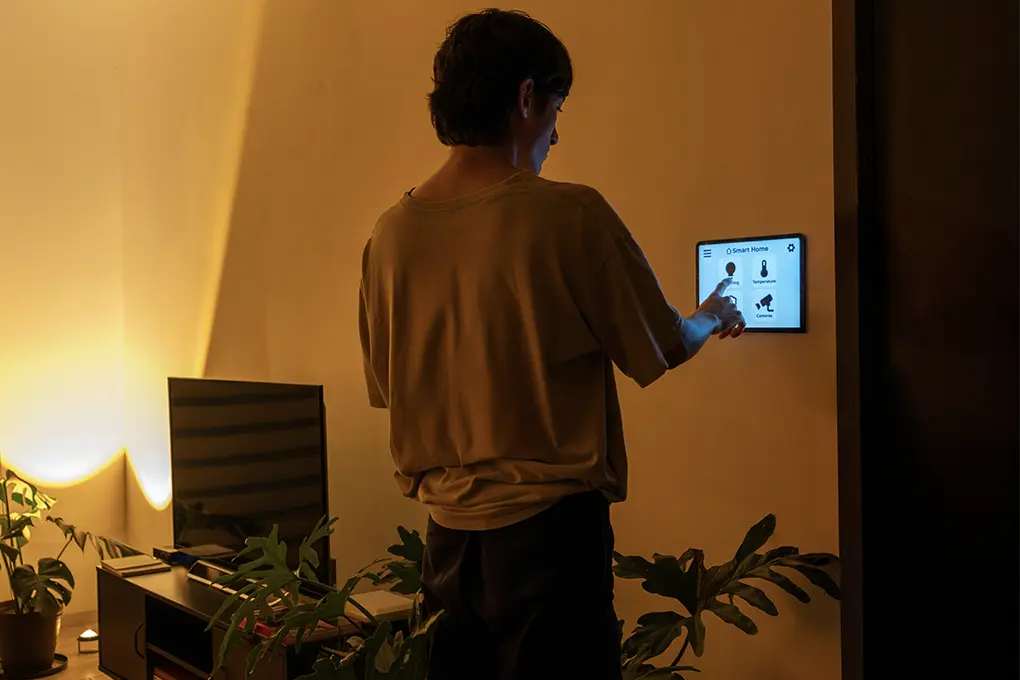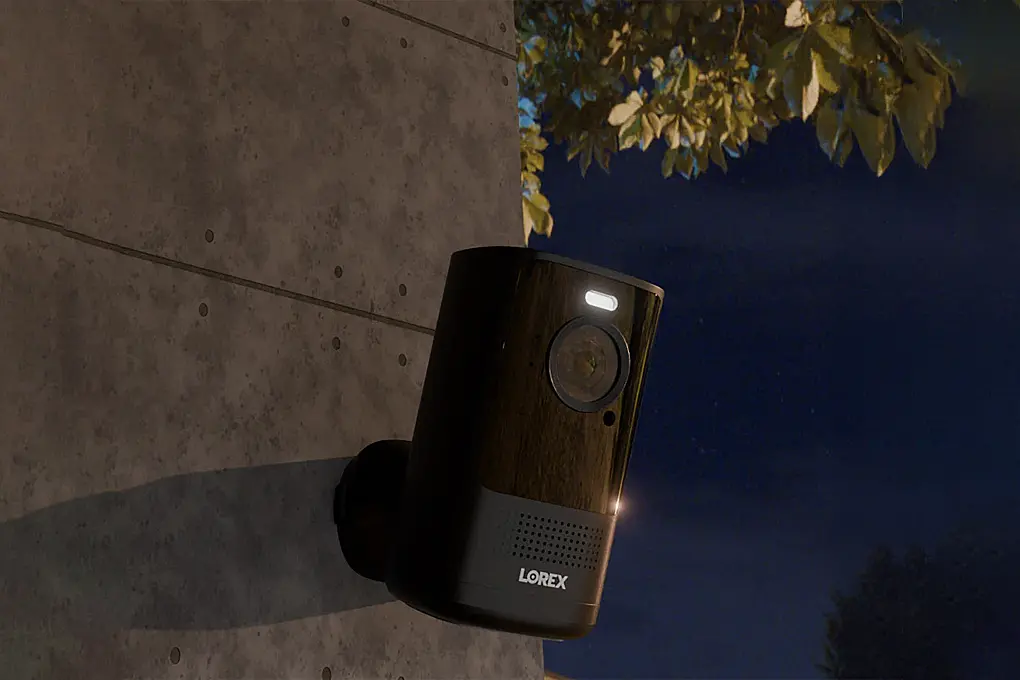Your power just went out. It’s pitch black, the wind is howling outside, and your phone’s only at 23%. Now ask yourself, is your home security system still working?
That’s the scenario more homeowners are thinking about as smart alarms surge in popularity. They’re convenient, high-tech, and increasingly common, but do smart alarms work without power? And just how reliable is your home security system in a power outage?
This isn’t a fringe concern. Nearly four out of five major U.S. power outages between 2000 and 2021 were caused by extreme weather. Even more alarming, the average number of weather-related outages has jumped by over 75% in the past decade alone. With storms and heat waves becoming more severe and unpredictable, blackouts aren’t just inconvenient; they’re expected.
Criminals know that a dark, powerless home is an easy target. That’s why understanding how your security system performs during an outage is no longer optional. In this guide, we’ll show you what actually works when the grid fails, what doesn’t, and how to make sure your system has your back, especially when you need it most.
Table of Contents
- Key Takeaways
- The Power Outage Reality Check
- How Different Security System Types Handle Power Loss
- Battery Backup Systems: Your First Line of Defense
- Advanced Backup Power Solutions
- Real-World Performance During Major Outages
- Cost-Benefit Analysis of Backup Power Options
- Practical Steps for Outage Preparedness
- Choosing the Right System for Your Outage Risk
- Integration With Home Emergency Planning
- The Bottom Line on Security Systems and Power Outages
- Frequently Asked Questions
Key Takeaways
- Power outages are becoming more frequent, lasting longer, and are often triggered by extreme weather events.
- Landline and cellular-based security systems offer better blackout performance than internet-only options.
- Battery backups typically last 6 to 24 hours, depending on usage and system configuration.
- Advanced solutions like UPS units, generators, and solar backups keep systems running during multi-day outages.
- System performance during real-world events like Hurricane Ian and Winter Storm Elliott shows the value of layered backup plans.
- Proper outage planning includes pre-outage testing, in-outage conservation, and post-outage inspection.
- Find a reliable security system with proven backup performance by browsing Batten’s expert-recommended options.
The Power Outage Reality Check
Power outages are far more common than most people think. According to the U.S. Energy Information Administration (EIA), the average American household experienced 5.6 hours of power interruptions in 2022, with 1.4 outages per customer that year. But these averages don’t reflect how widespread and disruptive blackouts have become in many regions.
Severe weather is now the leading cause of major outages across the country. Between 2000 and 2023, about 80% of all major power outages in the U.S. were weather-related. From hurricanes and ice storms to wildfires and heatwaves, these events have grown more intense and more frequent.
The 2023 American Housing Survey backs this up with household-level data. Roughly 33.9 million U.S. homes reported being completely without power at least once in the prior 12 months. Even more striking, 70% of those households said the outage lasted six hours or longer. That’s not just a flicker; it’s a serious security risk.
Some states experience this more than others. Texas, Michigan, and California top the list for the most frequent weather-related outages, followed closely by North Carolina and Ohio. And in places like Florida, Vermont, and West Virginia, average outage durations can exceed 10 to 19 hours per year.
When outages stretch on for hours or even days, your home security system needs to stay active. Unfortunately, many systems rely entirely on mains power or unstable internet connections, which means they go offline just when you need them most. That’s why understanding how your system handles power loss is crucial if you live in an area prone to blackouts.
Find out more about how to protect your home and family from extreme heat and blackouts.
How Different Security System Types Handle Power Loss
Not all security systems respond the same way during a blackout. The way a system is powered and how it communicates with monitoring centers plays a critical role in its reliability during an outage.
Below are the most common system types and their performance when the power goes out.
Traditional Landline Systems: The Old Reliable
Landline-based systems remain among the most dependable during power failures. Since landline telephone service typically continues even when electricity is out, these systems can maintain communication with monitoring centers. Most include a built-in battery backup that powers the main control panel for 12 to 24 hours.
For example, older ADT landline systems automatically switch to battery mode when the power cuts out. As long as the phone lines remain intact, alerts and emergency signals continue without interruption. This makes landline systems a strong choice in areas with frequent storms or unreliable electrical grids.
Internet-Based Systems: The Vulnerable Option
Systems that rely entirely on internet connections are more likely to fail during an outage. If your home router and modem lose power, the system loses its ability to communicate. Without a working internet connection, alerts can’t reach your phone or monitoring service.
Many entry-level WiFi security systems, like those from Wyze or Blink, become non-functional unless a separate power source backs up both the device and the internet hardware.
This limitation has prompted leading providers to include cellular backup as a built-in feature or paid upgrade. While helpful, cellular backup still depends on the system having sufficient battery life during the outage. Click here to find out how to prepare for power outages no matter the season.
The Cellular Advantage
Cellular-based security systems offer the most reliable performance during power outages because they operate independently of home internet and electrical systems.
Like your smartphone, these systems use cellular towers for communication, which typically remain operational during localized power failures.
How Cellular Backup Works
- Primary Communication: System attempts to connect via WiFi first
- Automatic Failover: When WiFi fails, system switches to cellular within seconds
- Continuous Monitoring: All alerts and notifications continue normally
- Battery-Powered Operation: System runs on backup batteries for extended periods
Popular Cellular-Enabled Systems and Their Costs
| System | Monthly Monitoring Cost | Cellular Backup Included | Battery Life |
| SimpliSafe | $21.99/month | Yes (Standard plan) | 8 to 24 hours |
| Ring Alarm | $20.00/month | Yes (Protect Pro) | 4 to 24 hours |
| ADT | $45.99 to $62.99/month | Yes (all plans) | 12 to 24 hours |
| Vivint | $29.99 to $49.99/month | Yes (all plans) | 4 to 24 hours |
| Frontpoint | $44.99 to $49.99/month | Yes (primary connection) | 6 to 24 hours |
The investment in cellular monitoring typically pays off during the first major outage, when families realize their security system continued protecting their home while neighbors with internet-only systems were left vulnerable.
Battery Backup Systems: Your First Line of Defense
A reliable home security system must continue working when the power goes out. Battery backup is the core safeguard that keeps systems operational during outages. But not all batteries perform the same. Knowing what to expect can help you prepare for short disruptions and plan ahead for longer ones.
Standard Battery Performance
Most modern security systems come equipped with a built-in battery that activates automatically when the power fails. While this provides immediate coverage, the actual duration depends on several key factors.
- Typical Duration: 6 to 24 hours, depending on the number of devices and system usage
- Battery Drain Factors: Age of the battery, number of active sensors, frequency of alerts or activations
- Armed vs. Disarmed Mode: Armed systems use 2 to 3 times more power due to continuous sensor monitoring
- Recharge Time: It can take 24 to 48 hours to fully recharge once power is restored
In testing, we found that even premium systems like Ring or SimpliSafe had battery duration variations depending on setup. For instance, homes with doorbell cameras, glass break sensors, or active monitoring consumed power more quickly during outages.
Check out the Battarix Backup Phone Charger to keep your communication systems in place.
Extending Battery Life During Outages
There are ways to stretch battery performance if an outage lasts longer than expected. Here are a few practical adjustments:
- Disable smart home features like lighting automation or voice assistants that aren’t essential for security
- Reduce motion sensor sensitivity to avoid constant triggering from pets or minor movement
- Limit how often you arm and disarm the system, especially through mobile apps
- Keep an eye on battery status through your security system’s app to know when it’s running low
These simple steps can add several hours to your system’s uptime during blackouts.
When Standard Batteries Aren’t Enough
While the average U.S. power outage lasts over five hours, millions of households face much longer disruptions. Hurricane Ian in 2022, for example, knocked out power to 2.6 million Floridians, with some areas left in the dark for over two weeks. We also have Hurricane Matthew, which knocked out power to over one million homes in Florida, Georgia, and South Carolina for an extended period.
In terms of winter power outages caused by weather, in February of 2025, a brutal winter storm caused power outages to over 400,000 homes, including in Kansas, Kentucky, Arkansas, West Virginia and Virginia – to the point where Governors issued states of emergency.
In cases like this, battery backup alone will not cut it. For families in high-risk regions or with critical home needs, additional power planning becomes essential. This includes adding uninterruptible power supplies (UPS) or investing in whole-home backup generators.
Smart security systems are only as dependable as the power source keeping them running. For long outages, a layered approach using standard batteries and alternative backup power can make the difference between protection and vulnerability.
Advanced Backup Power Solutions
When a basic battery won’t cut it, more advanced backup options can keep your home security system running through multi-day outages. Here’s how families can stay protected even when the grid is down for extended periods.
Uninterruptible Power Supplies (UPS)
A UPS is one of the simplest ways to provide backup power during short-to-medium outages. These compact devices kick in immediately when the power cuts, supplying electricity to critical equipment like your alarm system, smart hub, and even your WiFi router.
Why UPS Units Work Well for Security Systems
- Instant switchover when the power fails
- Protects devices from voltage spikes and surges
- Powers multiple devices, including routers and panels
- Affordable for most homes, typically priced between $50 and $200
- Offers two to eight hours of runtime depending on load
By connecting both your alarm panel and modem/router to a UPS, you can keep your internet-based system fully functional through typical outages. This option is ideal for areas where outages are usually resolved within a few hours.
Generator Solutions
For outages that stretch beyond a day, generators offer the most dependable solution. They supply continuous power to your entire home or selected systems, including alarms, cameras, lighting, and communication tools.
Two Main Types of Generators to Consider:
- Portable Generators: Range from $500 to $2,000. Require manual startup and ongoing fuel supply (usually gasoline or propane). Models like the Honda EU2200 stand out for their excellent performance.
- Standby Generators: Cost between $3,000 and $15,000. Turn on automatically and typically connect to your natural gas line.
Additional Generator Considerations:
- Always operate generators outdoors with proper ventilation to prevent carbon monoxide poisoning
- Schedule routine maintenance like oil changes and system testing
- Store fuel safely and follow local fire codes
If you’re looking for a great generator that can power appliances and so much more, the Generac GP8000E is a fantastic choice to consider.
For families in states like Florida or California, where outages are often tied to storms or fire-prevention shutoffs, a generator can be an essential home investment. Many homeowners report that a single prolonged outage justifies the cost.
Solar Power Backup Systems
Solar backup systems offer a sustainable, low-maintenance option for long-term outage protection. When paired with battery storage, they can power your home security system without relying on the grid or fuel.
Key Benefits of Solar Backup Systems:
- Silent operation with no fumes
- Charges automatically during the day
- Provides backup power for multiple days
- Completely independent from gas or utility lines
Costs can range from $1,000 to $5,000 depending on battery capacity and panel wattage. Some systems, like those by Bluetti or EcoFlow, include portable battery stations that integrate directly with low-wattage home devices, including alarm systems and routers.
Solar power isn’t just for off-grid living. It’s increasingly being used in suburban neighborhoods as a clean backup solution, especially in regions where outages coincide with sunny conditions. If you want a set-it-and-forget-it solution that also reduces long-term operating costs, solar might be the right fit. Find out how to protect your solar panels from electronic disturbance.
Real-World Performance During Major Outages
Looking at how home security systems hold up during real emergencies can help families make smarter choices about backup power. These recent events highlight the strengths and limitations of different setups.
Hurricane Ian (2022): Florida
During Hurricane Ian, over 2.6 million Floridians lost power. Families using systems like SimpliSafe or Ring with cellular backup reported that they continued to receive real-time alerts and monitoring. In contrast, those with WiFi-only setups often lost all functionality as internet service and router power failed.
The key takeaway from this event is that both cellular connectivity and backup power are critical. Many homeowners with UPS devices or portable generators were able to maintain basic system operations, while those with solar generators sustained security coverage for several days without needing fuel.
Families who prepared with multiple layers of backup, such as battery plus generator, were also able to keep food refrigerated, charge phones, and maintain communication with emergency services.
Winter Storm Elliott (2022): Multi-State
Winter Storm Elliott left over 1.5 million customers across states like Tennessee, West Virginia, and Wisconsin without power, some for more than 48 hours. Cellular-connected alarm systems generally continued functioning, but battery limits were tested.
In freezing conditions, the need for reliable heating added another layer of urgency. Homes equipped with standby generators not only maintained full security system operation, but also avoided the health risks of extreme cold.
This event emphasized the value of long-term backup solutions, especially in regions prone to harsh winter storms and extended outages.
Cost-Benefit Analysis of Backup Power Options
Investing in backup power for security systems requires balancing cost against risk tolerance and local conditions. Understanding the true cost of different approaches helps families make informed decisions.
Annual Cost Breakdown
| Solution | Initial Cost | Annual Operating Cost | Years to Break-Even |
| Extended Battery | $50 to 150 | $0 | Immediate |
| UPS System | $100 to 500 | $10 to 30 | 1 to 2 years |
| Portable Generator | $800 to 2,500 | $100 to 300 | 3 to 5 years |
| Solar Backup | $2,000 to 8,000 | $50 to 100 | 5 to 10 years |
The “break-even” calculation assumes avoiding one major security incident or maintaining system operation during three to five significant outages annually. For many families, the peace of mind value exceeds the pure financial calculation.
Consider that the average burglary results in over $2,600 in losses, while a home fire can cause $70,000+ in damage. Maintaining security and safety system operation during the vulnerable periods of power outages provides protection value that often justifies backup power investments.
Practical Steps for Outage Preparedness
Getting your home security system ready for power outages requires more than just having the right hardware. A proactive plan ensures your system stays online during the moments that matter most.
Pre-Outage Checklist
Before any outage occurs, make sure your system and backup tools are in working order:
- Test Battery Backup: Unplug the base station briefly to confirm the system stays powered.
- Check Battery Age: Most batteries degrade after three to four years. Replace if needed.
- Verify Cellular Connectivity: If your system includes cellular backup, test it to confirm functionality.
- Prepare Extra Power: Charge power banks and have your generator ready if you own one.
- Update Contact Info: Ensure your monitoring service has accurate contact details in case alerts are triggered.
These steps minimize surprises and give you peace of mind before storms or grid disruptions hit.
During-Outage Management
Once the power goes out, managing your system efficiently will stretch available backup power:
- Limit Activity: Avoid frequent arming or disarming to reduce battery drain.
- Track Battery Levels: Use your system’s mobile app or control panel to monitor battery status.
- Conserve Phone Battery: Keep phones charged for emergency use and notifications.
- Take Notes: Record any malfunctions so you can follow up after the outage.
Staying calm and efficient helps preserve power and maintains your home’s security throughout the outage.
Post-Outage System Care
After the lights come back on, a few quick checks can help maintain long-term reliability.
- Recharge Batteries: Most internal batteries need 24 to 48 hours to fully recharge.
- Test Your System: Check all cameras, sensors, and communication tools for normal operation.
- Inspect Outdoor Devices: Look for wind or water damage to motion sensors, cameras, or cables.
- Reset and Arm: Make sure all zones are active and reporting correctly.
- Schedule Maintenance: If anything seems off, book a technician to inspect and replace damaged components.
Addressing these items right away helps ensure you’re ready before the next outage rolls through.
Choosing the Right System for Your Outage Risk
Every home has a different level of exposure to outages based on location, infrastructure, and climate. Matching your security system’s capabilities to your risk level is critical for dependable protection.
High Outage Risk Areas (four or more outages annually)
- Use: Systems with cellular as the primary connection and 24+ hour battery backups
- Add: Generator or solar power for extended resilience
- Common Locations: Rural Texas, wildfire zones in California, hurricane-prone areas like Florida
Moderate Outage Risk Areas (one to three outages per year)
- Use: WiFi-based systems with reliable cellular backup and standard battery life
- Add: A small UPS for internet equipment to maintain connectivity
- Common Locations: Most U.S. suburbs, Midwest tornado regions, temperate coastal towns
Low Outage Risk Areas (less than one outage per year)
- Use: Internet-based systems with basic battery support
- Add: A low-capacity UPS for occasional, short outages
- Common Locations: Densely populated cities with underground utilities, like San Francisco or Washington D.C.
Understanding your outage frequency helps you make smart decisions on how much backup power to invest in. Being even slightly over-prepared now can prevent major headaches the next time your neighborhood goes dark.
Integration With Home Emergency Planning

Your security system’s backup power strategy should be part of a broader emergency preparedness plan. When power outages coincide with natural disasters, families often face multiple simultaneous risks. Planning ahead ensures your home remains protected and your family stays safe, even during extended disruptions.
How Security Systems Fit Into Emergency Plans
A reliable home security system is just one piece of a larger preparedness strategy. When developing a family emergency plan, it’s important to address how security integrates with power, communication, and evacuation efforts.
Key Considerations for Integration:
- Communication Systems: Ensure your security alerts can still reach you during outages by verifying cellular alerts and keeping devices charged.
- Power Allocation: Prioritize which systems will receive backup power. Include your security system alongside medical devices, refrigeration, and lighting.
- Evacuation Readiness: Set clear procedures for arming your system, locking entry points, and storing valuable items before leaving.
- Post-Event Recovery: After an outage or disaster, test your system fully and check for damage to external components.
Security systems can only function properly if they are part of a coordinated plan. Families should practice emergency scenarios in advance so everyone knows what to do when power or communication lines go down.
Prepare Based on Regional Threats
Disaster planning should also be tailored to the specific risks in your region. Power outages in Florida look very different from outages in Minnesota.
Our storm preparation guides cover:
- Winter Storms: Heating system protection, insulation, and power conservation
- Hurricanes: Flood-safe storage, secure communication, and long-term power strategies
By combining these resources, along with others, such as our earthquake preparation guide, with a security-focused backup plan, you’ll be far better positioned to maintain safety, communication, and control during extended outages.
The Bottom Line on Security Systems and Power Outages
Home security systems are only as reliable as the power and connectivity behind them. As outages become more frequent and severe, understanding how your system responds during blackouts is essential.
From short-term battery backups to long-term solutions like generators and solar power, each option plays a role in keeping your home protected. Cellular-enabled systems with layered backup power are the most dependable choice, especially for families in high-risk regions.
Smart planning, regular testing, and integrating your security setup into broader emergency prep can give you peace of mind when it matters most.
To ensure your system stays online during the next outage, choose a solution that fits your risk level, your budget, and your home’s specific needs. When the lights go out, your security system shouldn’t.
Want reliable security protection that doesn’t fail when the lights go out? Browse Batten’s expert-recommended home security systems, including cellular-enabled options with proven backup power performance, and start protecting what matters most, even during emergencies.
Frequently Asked Questions
How Long Do Most Security System Batteries Last During a Blackout?
Most last between 6 and 24 hours depending on how many devices are active and how frequently the system is triggered.
Can I Use a Power Bank to Extend My System’s Battery Life?
Yes, for some systems with USB-compatible base stations, high-capacity power banks can provide several additional hours of runtime.
Do Solar Panels Still Work During a Storm-Related Outage?
If paired with battery storage, solar panels can continue powering security systems even when grid service is interrupted by storms or fires.
What Happens If Cellular Towers Are Also Down During an Outage?
Cellular networks are designed with multiple redundancies. While rare, if towers are down, your system may store alerts until service is restored.
Are There Security Systems Specifically Designed for Off-Grid Use?
Yes. Some systems are built for off-grid living and include low-power operation, built-in solar charging, and satellite-based communication features.
Sources
- Surging Weather-related Power Outages | Climate Central
- U.S. electricity customers averaged five and one-half hours of power interruptions in 2022 – U.S. Energy Information Administration (EIA)
- How Do Power Outages Affect Households?
- Weather-related Power Outages Rising | Climate Central
- Landlines and Power Outages; should I have one?
- Fire Alarm Monitoring: Pros and Cons of Cellular vs. Landline/POTS – Fire Systems, Inc.
- Floods Trap Many in Florida, Knock Out Electricity for 2.6M as Hurricane Ian Heads to South Carolina | Chicago News | WTTW
- Power Outages after Hurricane Ian
- Over 200,000 US customers still without power after winter storm | Reuters
- If the Power Goes Out, Does My Security System Still Work?
- UPS for Security System
- The benefits of solar backup systems
- Winter Storm Elliott 2022: the Impact on the U.S. Power Grid and Recommendations for Resilience – NAES
- FBI — Burglary




